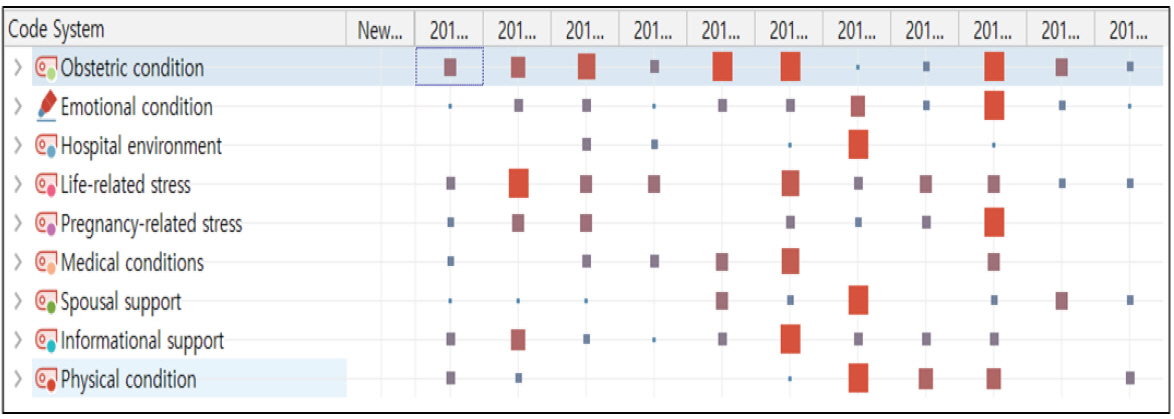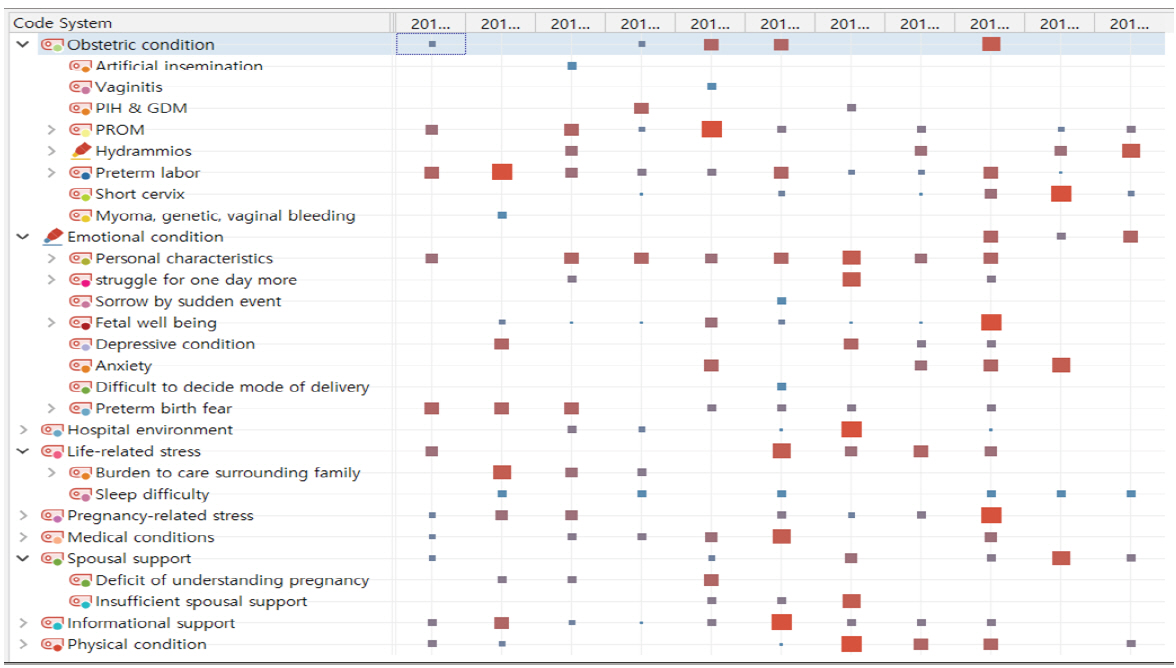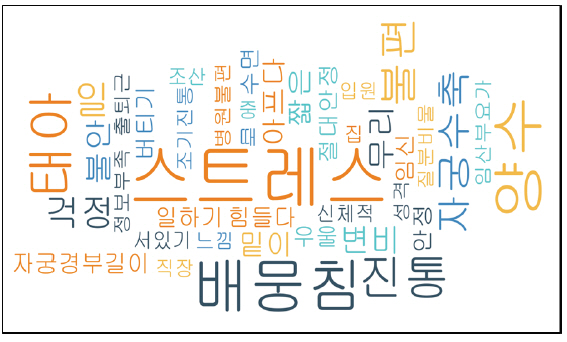Korean J Women Health Nurs.
2020 Sep;26(3):205-212. 10.4069/kjwhn.2020.08.08.
Visualization of unstructured personal narratives of perterm birth using text network analysis
- Affiliations
-
- 1School of Nursing, Soonchunhyang University College of Medicine, Cheonan, Korea
- KMID: 2506895
- DOI: http://doi.org/10.4069/kjwhn.2020.08.08
Abstract
- Purpose
This study aimed to identify the components of preterm birth (PTB) through women’s personal narratives and to visualize clinical symptom expressions (CSEs).
Methods
The participants were 11 women who gave birth before 37 weeks of gestational age. Personal narratives were collected by interactive unstructured storytelling via individual interviews, from August 8 to December 4, 2019 after receiving approval of the Institutional Review Board. The textual data were converted to PDF and analyzed using the MAXQDA program (VERBI Software).
Results
The participants’ mean age was 34.6 (±2.98) years, and five participants had a spontaneous vaginal birth. The following nine components of PTB were identified: obstetric condition, emotional condition, physical condition, medical conditions, hospital environment, life-related stress, pregnancy-related stress, spousal support, and informational support. The top three codes were preterm labor, personal characteristics, and premature rupture of membrane, and the codes found for more than half of the participants were short cervix, fear of PTB, concern about fetal well-being, sleep difficulty, insufficient spousal and informational support, and physical difficulties. The top six CSEs were stress, hydramnios, false labor, concern about fetal wellbeing, true labor pain, and uterine contraction. “Stress” was ranked first in terms of frequency and “uterine contraction” had individual attributes.
Conclusion
The text network analysis of narratives from women who gave birth preterm yielded nine PTB components and six CSEs. These nine components should be included when developing a reliable and valid scale for PTB risk and stress. The CSEs can be applied for assessing preterm labor, as well as considered as strategies for students in women health nursing practicum.
Keyword
Figure
Cited by 1 articles
-
Development Process for Preterm Birth Risk Assessment Scale in High-Risk Pregnancy: 1st Phase of Preliminary Scale Development
Jeung-Im Kim
J Korean Soc Matern Child Health. 2022;26(3):171-182. doi: 10.21896/jksmch.2022.26.3.171.
Reference
-
References
1. American College of Obstetricians and Gynecologists. Preterm (premature) labor and birth [Internet]. Washington, D.C: Author;2020. [cited 2020 Aug 20]. Available from: https://www.acog.org/patient-resources/faqs/pregnancy/extremely-preterm-birth.2. Adkins CS, Doheny KK. Exploring preterm mothers’ personal narratives: influences and meanings. ANS Adv Nurs Sci. 2017; 40(2):154–167. https://doi.org/10.1097/ANS.0000000000000150.
Article3. Dunkel Schetter C, Tanner L. Anxiety, depression and stress in pregnancy: implications for mothers, children, research, and practice. Curr Opin Psychiatry. 2012; 25(2):141–148. https://doi.org/10.1097/YCO.0b013e3283503680.
Article4. Kim YK, Lim KH. Risk factors for premature birth among premature obstetric labor women: a prospective cohort study. Korean J Women Health Nurs. 2018; 24(3):233–242. https://doi.org/10.4069/kjwhn.2018.24.3.233.
Article5. Kim JI, Cho MO, Choi GY. Multiple factors in the second trimester of pregnancy on preterm labor symptoms and preterm birth. J Korean Acad Nurs. 2017; 47(3):357–366. https://doi.org/10.4040/jkan.2017.47.3.357.
Article6. Maloni JA. Preventing preterm birth. Evidence-based interventions shift toward prevention. AWHONN Lifelines. 2000; 4(4):26–33. https://doi.org/10.1111/j.1552-6356.2000.tb01190.x.
Article7. Goldenberg RL, Culhane JF, Iams JD, Romero R. Epidemiology and causes of preterm birth. Lancet. 2008; 371(9606):75–84. https://doi.org/10.1016/S0140-6736(08)60074-4.
Article8. Research Committee of Women’s Health Nursing. Women’s health nursing II. Paju: Soomoonsa;2020. p. 316–317, 433-435.9. Cunningham F, Leveno K, Bloom S, Spong C, Dashe J, Hoffman B, et al. Williams obstetrics. 25th ed. New York, NY: McGraw-Hill Education;2018. p. 803–834.10. Samsung Seoul Hospital. Development of national patient transfer system for the integrated approach in high-risk mother and infant care. Seoul: Samsung Seoul Hospital;2015 Apr. Report No.: 11-1352000-001427-01.11. Ahn TG, Hwang JY. Maternity care system for high risk pregnant women in obstetrically underserved area. J Korean Med Assoc. 2016; 59:436–442. https://doi.org/10.5124/jkma.2016.59.6.436.
Article12. Raju TN. Epidemiology of late preterm (near-term) births. Clin Perinatol. 2006; 33(4):751–763. https://doi.org/10.1016/j.clp.2006.09.009.
Article13. Kwon Y, Cha M. A study on the research trend of resilience using keyword network analysis. Korean J Couns. 2016; 17(6):105–121.14. Yi I, Na E. Unstructured data analysis and visualization: Korean Journal of Industrial and Organizational Psychology (2010~2017). Korean J Ind Organ Psychol. 2018; 31(2):499–518.15. Engel S. The stories children tell: Making sense of the narratives of childhood. New York, NY: W. H. Freeman and Co;1995. p. 250.16. Peterson C, McCabe A. Developmental psycholinguistics: three ways of looking at a child’s narrative. New York: Springer;1983. https://doi.org/10.1007/978-1-4757-0608-6.
Article17. Statistics Korea. Preliminary results of birth and death statistics in 2019 [Internet]. Seoul: Author;2019. [cited 2020 Feb 26]. Available from: http://kostat.go.kr/portal/korea/kor_nw/1/1/index.board?bmode=read&aSeq=380865.18. Lilliecreutz C, Larén J, Sydsjö G, Josefsson A. Effect of maternal stress during pregnancy on the risk for preterm birth. BMC Pregnancy Childbirth. 2016; 16:5. https://doi.org/10.1186/s12884-015-0775-x.
Article19. Cole-Lewis HJ, Kershaw TS, Earnshaw VA, Yonkers KA, Lin H, Ickovics JR. Pregnancy-specific stress, preterm birth, and gestational age among high-risk young women. Health Psychol. 2014; 33(9):1033–1045. https://doi.org/10.1037/a0034586.
Article20. McDonald SW, Kingston D, Bayrampour H, Dolan SM, Tough SC. Cumulative psychosocial stress, coping resources, and preterm birth. Arch Womens Ment Health. 2014; 17(6):559–568. https://doi.org/10.1007/s00737-014-0436-5.
Article21. Sim ES, Choi SY. Relationship between preterm labor stress, anxiety and depression in pregnant women with preterm labor. J Korean Data Anal Soc. 2016; 18(2):951–964.22. Kim SH, Cho Chung HI. Stress, coping style and nursing needs for hospitalized pregnant women due to preterm labor. Korean J Women Health Nurs. 2015; 21(2):83–92. https://doi.org/10.4069/kjwhn.2015.21.2.83.
Article23. Ryu KH, Shin HS. Phenomenological study on experience of preterm labor. Korean J Women Health Nurs. 2009; 15(2):140–149. https://doi.org/10.4069/kjwhn.2009.15.2.140.
Article24. Mayo Clinic. Preterm labor; symptoms [Internet]. Rochester: Author;c1998-2020. [cited 2019 April 24]. Available from: https://www.mayoclinic.org/diseases-conditions/preterm-labor/symptoms-causes/syc-20376842.25. Chung JH. Obstetrical management of late preterm pregnancy. Perinatology. 2016; 27(4):195–204. https://doi.org/10.14734/PN.2016.27.4.195.
Article26. Roh HR, Rhee BD, Lee JT, Bae SK. Development of task-based learning outcomes according to clinical presentations for clinical clerkships. Korean J Med Educ. 2012; 24(1):31–37. https://doi.org/10.3946/kjme.2012.24.1.31.
Article27. Rhee BD, Park HK. The process of developing a clinical presentation curriculum. Hanyang Med Rev. 2012; 32(1):8–16.
Article28. Korea Association of Medical Colleges. Published the 2nd edition of “Learning Achievements in Basic Medical Education: Focused on Medical Competency” [Internet]. Seoul: Author;2016. [cited 2020 Apr 24]. Available from: http://webzine2.kamc.kr/webzine/tmpl/sub_main.php?st_id=20&m_cd=142&m_id=0302&wr_id=127.29. Gilbert ES. Manual of high risk pregnancy & delivery. 4th ed. St. Louis, MO: Elsevier Mosby;2007. p. 491–505.30. Lee KS, Ahn KH. Artificial neural network analysis of spontaneous preterm labor and birth and its major determinants. J Korean Med Sci. 2019; 34(16):e128. https://doi.org/10.3346/jkms.2019.34.e128.
Article
- Full Text Links
- Actions
-
Cited
- CITED
-
- Close
- Share
- Similar articles
-
- Text Mining in Biomedical Domain with Emphasis on Document Clustering
- Content Analysis of Patient Safety Incident Reports Using Text Mining: A Secondary Data Analysis
- Using Text Network Analysis for Analyzing Academic Papers in Nursing
- Analysis of Students Experience related of Nursing Management Clinical Practice: Text Network Analysis Method
- Analysis of Adverse Drug Reaction Reports using Text Mining




